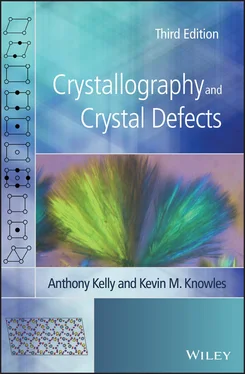6 2.6 In a holosymmetric cubic crystal the angle between (110) and a face P which lies in the zone [010] is 53.97°. Find the indices of P and calculate the angle between P and the face P′ related to P by the mirror plane parallel to (10). Determine the indices [uvw] of the zone containing P and P′ and calculate the interzone angle [uvw]∧[10].
7 2.7Calculate the angle between [0001] and [113] in beryllium (hexagonal, a = 2.28 Å, c = 3.57 Å). What face lies at the intersection of the zones [113] and [113]?In a crystal of calcite (trigonal; c/a = 0.8543), a face lies in the zone between (101) and (101) at an angle of 16.50° from (101). Determine the indices of this face.
8 2.8 In an orthorhombic crystal (topaz) with axial ratios a : b : c = 0.529 : 1 : 0.477, the following angles were measured to the face P of the general form: (100)∧P = 67.85°, (010)∧P = 66.5°. Determine the indices of P.
9 2.9 Calculate the axial ratios a : b : c and the axial angle β for a monoclinic crystal (gypsum) given that (110)∧(10) = 68.5°, (001)∧(10) = 82.3° and (001)∧(01) = 33.1°.
10 2.10In a hexagonal zeolite crystal the angle (100)∧(101) is found to be 37.2°. Calculate the axial ratio c/a and specify the indices of the zone containing both faces in (i) conventional three‐dimensional indices and (ii) the Weber 4‐index notation.Show that (0001)∧(112) = 48.8°. Hence, construct a stereogram centred on 0001 showing all the poles of the form {100}, {101}, {110} and {112} for this zeolite.
11 2.11 α‐sulfur forms orthorhombic holosymmetric crystals with a = 10.48 Å, b = 12.92 Å and c = 24.55 Å.Draw a sketch stereogram showing the symmetry elements shown by α‐sulphur.Calculate the angles (001)∧(011) and (100)∧(110). Insert these poles on a stereogram.Hence, draw an accurate stereogram of sulphur showing all the faces of the forms {100}, {010}, {001}, {101}, {110}, {111}, {011} and {113}. Index all the faces in the upper hemisphere. Which of these are general and which are special forms?
12 2.12 In dealing with some imperfect crystals with a cubic face‐centred lattice it is convenient to use a hexagonal unit cell. The cubic face‐centred lattice can be referred to a hexagonal cell where the z‐axis is parallel to [111] and of magnitude , where a is the lattice parameter of the conventional cubic unit cell and the x‐ and y‐axes are parallel to the 〈101〉 directions perpendicular to [111] and of magnitude .Draw a diagram showing the relation between the two unit cells.Write the hexagonal lattice vectors in terms of the cubic lattice vectors. Hence, derive the matrix for transforming the indices of lattice planes.Find the ratio of the volumes of the two unit cells by the matrix method and check by direct calculation. How many lattice points does each contain?Obtain the hexagonal indices of the planes with indices (112), (100) and (10) referred to the conventional cubic cell.
Suggestions for Further Reading
See the suggestions for Chapter 1 as well as the following:
1 Janssen, T. (1973). Crystallographic Groups. North‐Holland, Amsterdam.
2 Wooster, W.A. (1973). Tensors and Group Theory for the Physical Properties of Crystals. Oxford: Clarendon Press.
1 [1] Buerger, M.J. (1963). Elementary Crystallography. New York: Wiley.
2 [2] Phillips, F.C. (1971). Introduction to Crystallography, 4th Edition. Edinburgh: Oliver & Boyd.
3 [3] Aroyo, M.I. (ed.) (2016). International Tables for Crystallography, 6th, Revised Edition, Vol. A: Space‐Group Symmetry, published for the International Union of Crystallography. Chichester: Wiley International.
4 [4] Henry, N.F.M. and Lonsdale, K. (eds.) (1952). International Tables for X‐Ray Crystallography, Volume I, International Union for Crystallography. Birmingham, England: Kynoch Press.
5 [5] de Jong, W.F. (1959). General Crystallography: A Brief Compendium. New York: W.H. Freeman.
6 [6] Bravais, A. (1866). Études Cristallographiques, p. 119. Paris: Gauthier‐Villars.
7 [7] Friedel, G. (1926). Leçons de Cristallographie, p. 80. Nancy‐Paris‐Strasbourg: Berger‐Levrault.
8 [8] Weber, L. (1922). Das viergliedrige Zonensymbol des hexagonalen Systems. Z. Kristallogr. 57: 200–203.
9 [9] Ewald, P.P. (ed.) (1962). Fifty Years of X‐Ray Diffraction. Utrecht: N.V.A. Oosthoek.
10 [10] Carpenter, M.A. and Howard, C.J. (2009). Symmetry rules and strain/order‐parameter relationships for coupling between octahedral tilting and cooperative Jahn–Teller transitions in ABX3 perovskites. I. Theory. Acta Crystallogr. B 65: 134–146.
11 [11] Carpenter, M.A. and Howard, C.J. (2009). Symmetry rules and strain/order‐parameter relationships for coupling between octahedral tilting and cooperative Jahn–Teller transitions in ABX3 perovskites. II. Application. Acta Crystallogr. B 65: 147–159.
12 [12] Howard, C.J. and Carpenter, M.A. (2010). Octahedral tilting in cation‐ordered Jahn–Teller distorted perovskites – a group‐theoretical analysis. Acta Crystallogr. B 66: 40–50.
13 [13] Schoenflies, A. (1891). Krystallsysteme und Krystallstructur. Leipzig: B.G. Teubner.
14 [14] Hermann, C. (1928). Zur systematischen Strukturtheorie I. Eine neue Raumgruppensymbolik. Z. Kristallogr. 68: 257–287.
15 [15] Mauguin, C. (1931). Sur le symbolisme des groupes de répétition ou de symétrie des assemblages cristallins. Z. Kristallogr. 76: 542–558.
16 [16] Atkins, P.W., De Paula, J. and Keeler, J. (2017). Atkins' Physical Chemistry, 11th Edition. Oxford: Oxford University Press.
17 [17] Burns, G. and Glazer, A.M. (1990). Space Groups for Solid State Scientists, 2nd Edition. New York: Academic Press.
18 [18] Mathews, J. and Walker, R.L. (1970). Mathematical Methods of Physics, 2nd Edition. Reading, MA: Addison‐Wesley.
19 [19] Riley, K.F., Hobson, M.P. and Bence, S.J. (2006). Mathematical Methods for Physics and Engineering, 3rd Edition. Cambridge: Cambridge University Press.
20 [20] Hahn, T. (ed.) (2002). International Tables for Crystallography, 5th, Revised Edition, Vol. A: Space‐Group Symmetry, published for the International Union of Crystallography. Dordrecht: Kluwer Academic Publishers.
21 [21] Urusov, V.S. and Nadezhina, T.N. (2009). Frequency distribution and selection of space groups in inorganic crystal chemistry. J. Struct. Chem. 50: S22–S37.
22 [22] Padmaja, N., Ramakumar, S. and Viswamitra, M.A. (1990). Space‐group frequencies of proteins and of organic compounds with more than one formula unit in the asymmetric unit. Acta Crystallogr. A 46: 725–730.
23 [23] Wukovitz, S.W. and Yeates, T.O. (2005). Why protein crystals favour some space‐groups over others. Nat. Struct. Biol. 2: 1062–1067.
24 [24] Mackay, A.L. (1957). Extensions of space‐group theory. Acta Crystallogr. 10: 543–548.
25 [25] Heesch, H. (1930). Über die vierdimensionalen Gruppen des dreidimensionalen Raumes. Z. Kristallogr. 73: 325–345.
26 [26] Shubnikov, A.V. and Kopstik, V.A. (1974). Symmetry in Science and Art. London: Plenum Press.
27 [27] Shull, C.G., Strauser, W.A. and Wollan, E.O. (1951). Neutron diffraction by paramagnetic and antiferromagnetic substances. Phys. Rev. 83: 333–345.
28 [28] Litvin, D.B. (2013). Magnetic Group Tables, 1‐, 2‐ and 3‐Dimensional Magnetic Subperiodic Groups and Magnetic Space Groups. Chester: International Union of Crystallography. Available free online from http://www.iucr.org/publ/978-0-9553602-2-0.
1 1 It is also possible to use rotoreflection axes [1], pp. 23–30, also termed alternating axes [2], p. 117, in developing the point groups. These repeat an object by rotation coupled with reflection in a plane normal to the axis. Onefold, twofold, threefold, fourfold, and sixfold rotoreflection axes are possible, usually denoted (pronounced ‘one tilde’), , , and respectively. is clearly equivalent to a mirror plane.
Читать дальше












